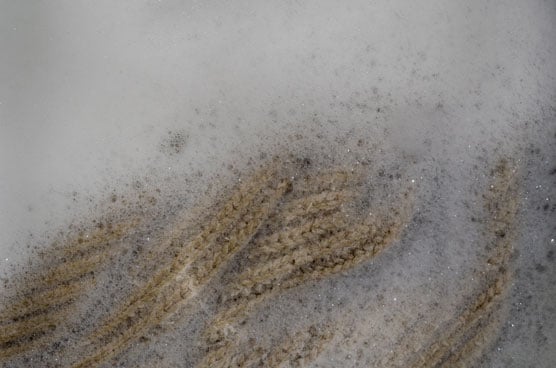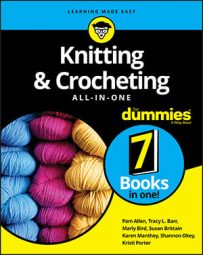If the yarn label says “Dry clean only,” then by all means, take the item to the cleaners. A word of advice, though: Bring the label (or a copy of the label) to the cleaners with you. That way they’ll know what material they’re working with and can use the appropriate chemicals.
 ©Dmitriev Mikhail/Shutterstock.com
©Dmitriev Mikhail/Shutterstock.comHandwashing
Unless the yarn specifically states “dry clean only,” handwashing is your best option. Here’s how:- Grab a bottle of mild detergent and make sure your sink or bathtub is clean. The best soap to use is a mild laundry detergent formulated for delicate items or baby clothes, such as Woolite or Ivory Soap. For small items, the kitchen sink is the perfect size. For larger items such as afghans, the bathtub or washtub works better.
- Fill the sink or tub with enough cool to warm water so the item can be submerged.
- Swish the item around gently. By keeping the agitation to a minimum, you preserve the integrity of the stitches.
- After washing, rinse thoroughly and squeeze out excess moisture.
Rinse the item under cool water until it runs clear.
Never wring a knitted or crocheted item because the twisting motion can stretch the stitches and ultimately ruin the item’s shape.
- Wrap the item in towels to absorb the extra moisture and lay flat to dry, blocking as necessary.
Never hang a crocheted piece to dry (it will stretch out of shape beyond recognition), and please, keep items out of the sun, which can cause fading.
Machine washing and drying
In some cases, it’s perfectly fine to throw your masterpieces in the washing machine. This holds true for items made from synthetic yarns, such as acrylic, which won’t sustain so much damage from the washing machine. Use the delicate cycle and, if size permits, throw the item into a mesh laundry bag. Be sure to check the yarn label for the correct water temperature settings.It’s always a safe bet to wash these items alone the first time around, just to make sure the colors won’t bleed into the rest of your laundry. If you’re not sure what the correct water temperature should be, opt for the safe route and use the cool water setting.
Sometimes tossing your afghan, scarf, or other piece of handiwork in the dryer is just fine. Again, check the yarn label to make sure it’s okay. Most synthetic yarns will take a low heat setting unless it’s got some stuff attached like sequins or mirrors. Add some smooth-textured items like pillowcases to the dryer to help absorb moisture.Don’t machine dry wool — it will shrink! Find a spot large enough to accommodate the piece and lay it out flat, shape it if necessary, and allow to dry, preferably in a place that is out of direct sunlight and won’t be disturbed by playful pets.
Iron only if you must
If you feel that you need to add some heat to an item to get all the wrinkles out, set the iron on the lowest heat setting suggested for the yarn. Place a slightly damp cloth, such as a clean cotton dish towel, on top of your piece before ironing.Never allow the iron to come into direct contact with the yarn. Excessive heat can ruin the integrity of the yarn fibers, and even cotton thread can flatten out too much and ruin the original look of the design.
Remove those pesky pills
It’s inevitable — where there’s yarn there’s pills, those unsightly little balls that pop up on fabric after laundering or from normal wear and tear. Removing the pills can revitalize your pieces and make them look like new again.You can get rid of pills two ways:
- By using a sweater stone: This is the recommended preference because it is gentler on the fabric and you have more control over it.
- By using a sweater shaver: These devices are typically battery operated or electric, and if you don’t use them properly, you can put holes in your item.
- Lay the item on a flat surface.
- Hold the stone in the palm of your hand and gently brush the fabric in smooth short strokes.
Never, ever try to remove pilling with scissors! Remember that knits and crochet are a series of interlocking loops; if you inadvertently cut even one of the strands of yarn, your whole piece can unravel.

